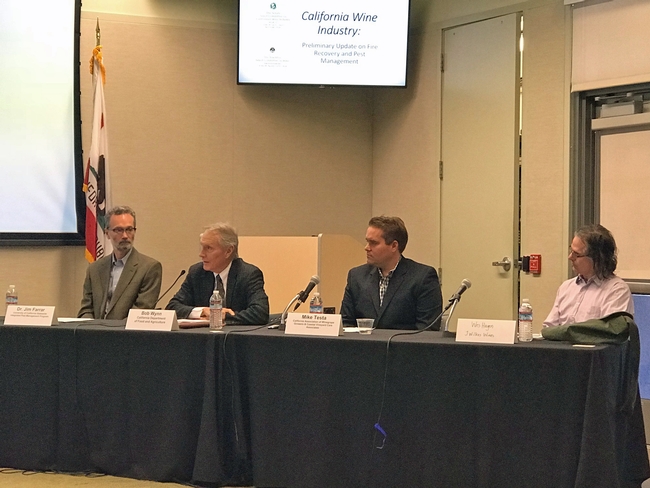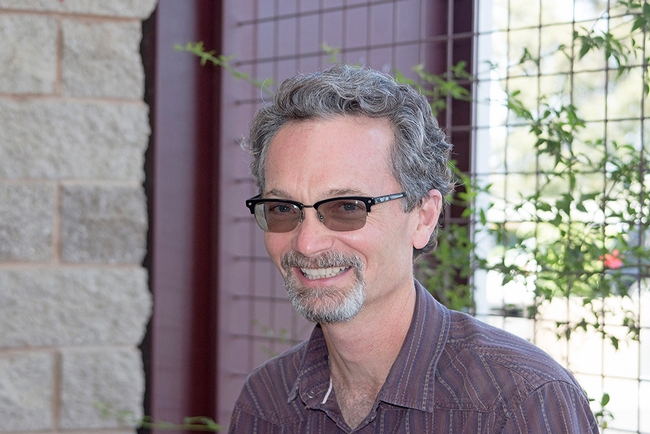
Posts Tagged: Farrar
UC IPM director issues statement regarding the California ban on chlorpyrifos
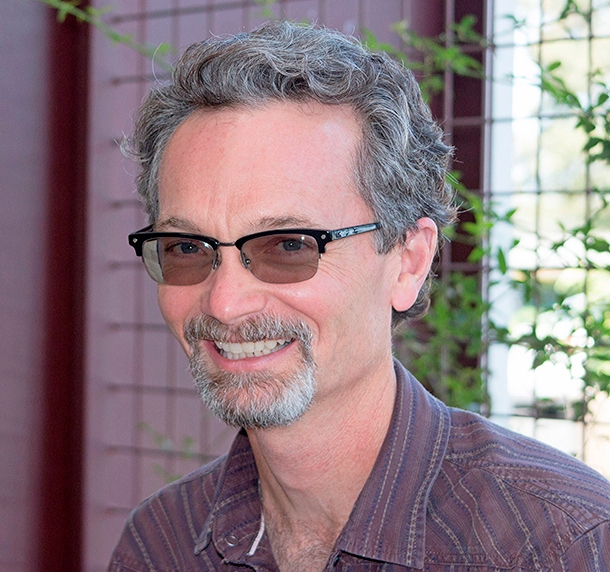
"On Wednesday, May 8, 2019, the State of California announced it would ban the use of chlorpyrifos by canceling registration of the pesticide by the Department of Pesticide Registration. Chlorpyrifos use in agriculture has been under federal and state regulatory review for the last several years. Chlorpyrifos for use in structural pest control and for sale in consumer products ended in 2000 due to a voluntary agreement between the manufacturers and EPA.
"University of California Agriculture and Natural Resources (UC ANR) carries out the Land-Grant mission of University of California to seek scientific solutions to address society's needs and problems. As a part of UC ANR, the Statewide Integrated Pest Management Program (UC IPM) provides research-based information to manage pests while protecting human-health and the environment. UC scientists have spent many years researching alternatives to chlorpyrifos and educating state-licensed pest control advisers on effective use of the alternatives. For example, improved integrated pest management of insects in almonds eliminated the need for winter application of chlorpyrifos on the 1,390,000 acres of almonds in California. Overall, this work contributed to the greater than 50% decrease in chlorpyrifos use in all of California agriculture from 2006 to 2016.
"In 2014, UC IPM started a two-year project, funded by California Department of Pesticide Regulation, to identify the pest-crop situations where there were no or few alternatives to chlorpyrifos. That project identified specific needs for additional research on alternatives to manage weevils and aphids in alfalfa, leaf-footed bug and stink bugs in almond, ants in citrus, and aphids and whiteflies in cotton. UC research and extension continues to seek solutions to these difficult pest management problems. Previous research in many other pest-crop situations had already identified and supported implementation of alternatives to chlorpyrifos.
"UC ANR will continue to work closely with the State of California and agriculture to protect the health of Californians and our environment while providing effective pest management solutions to farmers."
For more information, contact:
Jim Farrar
(530) 750-1249, jjfarrar@ucanr.edu
Eat a Bug for Giving Tuesday?
#GivingTuesday is November 27! Want to know how you can support the work we do here at the UC...
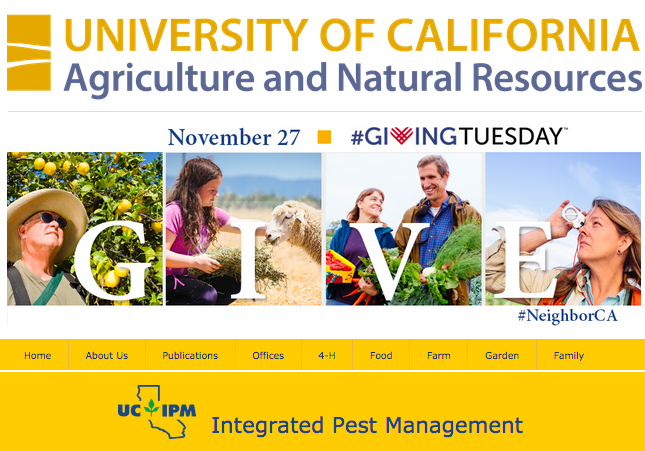
Giving Tuesday UC IPM
April News Clips
This geneticist is creating gene-edited animals for our plates
(Ozy.com) Marissa Fessenden, April 29
Animal geneticist Alison Van Eenennaam has six calves that are rather unusual. Most people might not pick up on what's odd, but close inspection, and knowledge of bovine genetics, reveals that none of the calves have horns despite being a mix of breeds that typically have them. Even more surprising? The calves' hornless state wasn't bred into them — Van Eenennaam and her colleagues edited their genes using the new CRISPR technology.
Board approves mural honoring Orloff, Siskiyou's heritage
(Siskiyou Daily) Danielle Jester, April 19
A mural that will honor the late Steve Orloff, former Siskiyou County farm advisor, and recognize agriculture in the county was approved Tuesday by the Siskiyou County Board of Supervisors.
Rob Wilson, who is the director and farm advisor at the Intermountain Research Center Extension in Tulelake and is serving as the the interim acting county director for Siskiyou County Cooperative Extension, noted that the mural presents a "great opportunity to honor agriculture in Siskiyou County and to try to honor former Farm Advisor Steve Orloff."
http://www.siskiyoudaily.com/news/20180419/board-approves-mural-honoring-orloff-siskiyous-heritage
Letter: Livestock impact on environment overstated in 'Meatless Monday' column
(Lafayette IN Journal & Courier) Frank Mitloehner
I am responding to the recent contribution titled, “Meatless Mondays: Consequences for our dining habits."
What a nutritionist wants you to know about pesticides and produce
(NBC News) Samantha Cassetty, April 15
This week, the Environmental Working Group (EWG) released an update to their annual Dirty Dozen and Clean 15 lists. These lists reveal produce with both the highest and lowest levels of pesticide residue, according to their methodology. The report looks more or less the same as last year's guide, with strawberries claiming the unfortunate number one spot, edging out spinach and nectarines.
… But let's get one thing clear: Organic produce is not pesticide-free. There are pesticides used in organic farming, but they're derived from natural substances rather than synthetic ones, And as Carl Winter, Ph.D., Extension Food Toxicologist and Vice Chair, Food Science and Technology at University of California, Davis puts it, in either case, “the dose makes the poison.”
OPINION: Should California Winemakers Be Worried About China's Tariffs?
(NPR) Julian M. Alston, director, Mondavi Institute for Wine Economics, UC Davis; Daniel Sumner, Olena Sambucci, Agricultural and Resource Economics, UC Davis
California's vintners and grape growers are among the latest potential victims in the escalating trade spat between the U.S. and China.
Responding to U.S. plans to impose import duties on goods from China, the Chinese Ministry of Commerce reciprocated by introducing new tariffs on 128 U.S. products, including an additional 15 percent import tariff on wine.
"We are open for business" is message from wine committee joint meeting
(Sonoma West) Heather Bailey, April 9
At the April 6 Joint Information Hearing of the California State Senate Select Committee on California's Wine Industry and the California Assembly Select Committee on Wine the overarching theme of the meeting was: “We are open for business.” While there are impacts from the October fires, the message went, stories of our demise are greatly exaggerated. So come on down for your corporate event, wine tasting weekend, wedding or bachelorette party.
…The final panel on Water Supply featured Glenn McGourty, Viticulture and Plant Science Advisor in Mendocino County for the UC Cooperative Extension, Dr. Michael Anderson, California State Climatologist at the California Department of Water Resources, Eric Larson, Environmental Program Manager at the California Department of Fish and Wildlife, and Katie Jackson, Vice President for External Affairs and Sustainability at Jackson Family Wines.
McGourty discussed some of the scientific advances being brought to bear for assisting the wine industry with its water usage, including surface renewal technology, which will tell a grower exactly how much and when to irrigate and could save 50 to 100,000 gallons of water per acre, using crop cover on the soils, which allows soil in one acre to hold an additional 38,000 more gallons of water, and various ways to control frost in vineyards so that irrigation isn't needed to prevent frost.
County program to cull dead trees continues
(The Union Democrat) Alex Maclean, April 5
Scientists doing field-based research saw a decline in the death rate of ponderosa pines from western bark beetle infestation last year, but Tuolumne County isn't slowing down its effort to help landowners affected by the drought-induced epidemic.
… Jodi Axelson, a Cooperative Extension specialist in forest health at University of California, Berkeley, said the slowing of mortality seen over the past year should give counties like Tuolumne an opportunity to catch up on removing dead trees from private property.
Axelson is part of a team of scientists collecting data on tree mortality that also includes John Battles, a forest ecology professor at UC Berkeley, and Susie Kocher, a natural resources advisor for UC Cooperative Extension, Central Sierra.
http://www.uniondemocrat.com/localnews/6140772-151/county-program-to-cull-dead-trees-continues
Land suitable for certain California crops expected to shrink
(Agri-Pulse) Steve Davies, April 5
California growers should start to look seriously at how to adapt to a changing climate, which could shrink the land available for many of the state's most popular crops, a new study has found.
“Reduced numbers of chill hours, increased pest pressure, increased water demand and water-induced stress, as well as variable and unreliable water supply, are examples of factors that are projected to adversely impact the yield and quality of various crops grown in California,” says the paper, published in the journal Agronomy. Chill hours are traditionally defined as those periods where the temperature is below 45 degrees Fahrenheit.
"Understanding climate change and how it is impacting agriculture can help us develop relevant adaptation strategies and enhance agricultural resilience to climate risks," said lead author Tapan Pathak, a cooperative extension specialist at the University of California Division of Agriculture and Natural Resources.
Search for wine ‘smoke taint' solutions intensifies after Northern California wildfires
(North Bay Business Journal) Jeff Quackenbush, April 4
The international pursuit of ways to predict how much smoke from a wildfire will end up in finished wine and what to do about it got a boost when the dark clouds of particles pumped out by the massive North Bay fires in October descended on the University of California, Davis, experimental vineyard in Napa Valley.
“The moment the smoke started, my phone started ringing off the hook,” said Anita Olberholster, Ph.D., a specialist in the science of winemaking for University of California Cooperative Extension. When the fires erupted Oct. 8, most of the North Coast winegrape crop had been picked, but some late-ripening fruit, particularly cabernet sauvignon was still on the vine, in the home stretch of the 2017 harvest. “It quickly realized how thin the data is I need to base recommendations on.”
For these Central Coast students, spring break is a chance to hone their culinary skills
KSBY, April 4
Some local fifth and sixth graders are spending their spring break in the kitchen.
The students are part of the 4-H Student Nutrition Advisory Council clubs at five schools in Santa Maria and Oceano.
During the third annual "Culinary Academy," they're learning food safety habits, how to safely handle knives, baking techniques, and stovetop skills. Specifically, they're cooking up healthy blueberry muffins, sushi, and an egg omelet.
"It's really an opportunity for the kids to learn some basic food skills along with nutrition and some fun thrown in there, too," said Janelle Hansen, 4-H program supervisor for Santa Barbara County.
Culinary Academy teaches Santa Maria spring breakers how to cook
Santa Maria Times, April 4
Fifth and sixth grade youth leaders from five school-based 4-H Student Nutrition Advisory Council clubs (SNAC) worked to develop their culinary skills over Spring Break.
Over 20 SNAC Youth leaders participated in the 3rd annual Culinary Academy, at Liberty Elementary School in Santa Maria. This year youth worked on recipes to enhance their knife and stove top skills, food safety habits, and baking techniques.
UC Climate Video Questioned by UC Researchers
(UCD Aggie) David Madey, April 4
According to a video called “The diet that helps fight climate change” released by the Office of the UC President, everyone — including the 238,000 students across the UC system — can help combat climate change on their own. But not everyone is celebrating.
… “[The video] recommended for the global population a diet that only the top one percent can afford,” said Dr. Frank Mitloehner, a professor and air quality specialist at UC Davis. “We could not even satisfy a Mediterranean diet for the entire United States population today.”
… Dr. Glenda Humiston, the vice president for the UC Division of Agriculture and Natural Resources, wrote in a public letter to UC colleagues, “[The video] states that if the world was to reduce its meat consumption, that decision alone could offset the emissions from a billion cars on the road by 2050. For the U.S., however, this contention is misleading, as the impact would be considerably smaller.”
Dr. Alison Van Eenennaam, an expert featured in “Food Evolution” from UC Davis, also claims that the Climate Lab video is misleading. With a combined 2.1 million views on YouTube and Facebook to date, Van Eenennaam expressed concern that the public is led to believe that diet is twice as important as transportation effects –– which is not true at all, she said.
“It's not simple, and that video made it simple,” Van Eenennaam said.
https://theaggie.org/2018/04/04/can-diet-diminish-climate-change-see-video.
Future Of Farming Blossoming At UC Davis
(CBS Sacramento)
Researchers are looking for ways to make farming a little smarter with robots and drones that could one day revolutionize the way our food is grown.
Engineers at UC Davis are trying to be on the forefront of future farming technology.
“Smart technologies are going to allow us to be more efficient,” said professor David Slaughter.
They're inventing things like a high-tech hoe that uses ultraviolet lights and cameras along with specially treated plants to trim away weeds. Computer-controlled red cutting blades open up just in time to let plant stems pass by unharmed.
http://sacramento.cbslocal.com/2018/04/03/uc-davis-farming-future-robots/
Drought put UC's water-saving strategies into practice
(Western Farm Press) Tim Hearden
The historic drought from 2012 to 2016 forced almond growers to put into practice water-conservation strategies they'd been taught by University of California Cooperative Extension crop advisors — so say a farmer and an advisor in a newly released video on water management.
Raj Meena of the Gustine, Calif.-based Meena Farms, says tools such as the pressure chamber, which measures water stress in trees, and soil moisture monitoring helped the operation survive drastic cutbacks in water. “I would say our water management improved considerably because it had to,” he says in the video, part of series on drought tips from the UC California Institute for Water Resources. “If we hadn't done that, we wouldn't still be farming. When you're so regulated in the water that you have, you have to allocate it very carefully.”
http://www.westernfarmpress.com/tree-nuts/drought-put-uc-s-water-saving-strategies-practice
UC program aids in citrus disease fight
(AgAlert) Christine Souza
At war with the Asian citrus psyllid since it was found in San Diego County in 2008, California citrus growers and packers have had unprecedented success in slowing the spread of the tree-killing bacteria the psyllid can carry. People in the citrus business say part of that success relates to the testing and distribution of clean citrus plant material through the University of California, Riverside.
The Citrus Clonal Protection Program at UC Riverside tests clonal material to ensure that citrus varieties introduced into California remain free of pathogens.
Joel Nelsen, president of California Citrus Mutual, said he believes work such as that done by the program has helped defend California citrus from the tree-killing bacterial disease huanglongbing or HLB, also called citrus greening.
http://agalert.com/story/?id=11738
California fights costly battle against invasive species
(Agri-Pulse) Tyler Ash
Every year, California acquires on average nine new invasive species, including exotic insects, spiders, mollusks and even South American mammals. Three of those invaders usually try and settle down, start a large family and stake a claim on some of the Golden State's endless buffet of agricultural crops, becoming the bane of farmers and researchers.
“There are lots of species that get here and don't become established, it's just a few that do,” said Jim Farrar, director of the Statewide Integrated Pest Management Program of the University of California Division of Agriculture and Natural Resources.
According to the UC-Riverside's Center for Invasive Species Research, invasive pests cost the state an estimated $3 billion a year. Intrusive plants alone cost California at least $82 million annually for control, monitoring and outreach, not including crop loss, as reported by the California Invasive Plant Council.
https://www.agri-pulse.com/articles/10774-california-fights-costly-battle-against-invasive-species
UC Davis researchers on a hunt for backyard chicken eggs around the Thomas Fire burn scar
(Ventura County Star) Cheri Carlson, April 3
Veterinarians at UC Davis have put out a call for eggs from California's backyard chicken owners, particularly those living near the Thomas Fire and other recent blazes.
They want to test the eggs for free in an effort to understand how they might be affected by wildfires, lead and other environmental factors.
It's called the Backyard Chicken Egg Study. And, they need help from backyard chicken enthusiasts, said Maurice Pitesky, a faculty member at the UC Davis School of Veterinary Medicine-UC Cooperative Extension.
“We're trying to understand the connection between the environment and our backyard chickens,” said Pitesky, who teamed up with colleague Birgit Puschner to test the eggs.
Related:
Backyard Chicken Owners Can Have Eggs Tested For Free By UC Researchers
(SF Gate) Bay City News Service, April 3, 2018
Bay Area Chicken Owners: UC Testing Eggs For Free
(Bay City News Service)
UC IPM’s Farrar briefs legislators on threats to California winegrapes
Recent surveys in the North Coast have found that 90 percent of the powdery mildew samples collected were resistant to strobulurin fungicides, the director of UC Integrated Pest Management Program told legislators at a joint hearing of the California Assembly and Senate Select Committees on California's Wine Industry. A potential solution is breeding winegrapes to be resistant to powdery mildew, but a drawback is that the wine industry is largely known for its varietals.
“Professor Andy Walker at UC Davis has succeeded in crossing winegrapes with a wild grape species that is naturally resistant to powdery mildew and then crossing the offspring back to the parent winegrape variety for several generations,” said James Farrar, who was invited to speak at the committees' informational hearing on “Fire Recovery and Pest Management Awareness” at UC Santa Barbara on Nov. 7.
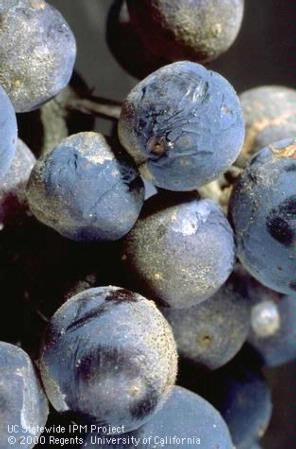
Farrar warned the legislators of increased human health risks due to “unintended consequences of social pressure” on the herbicide glyphosate, which growers use to control weeds under grapevines rather than tilling the soil, to comply with Natural Resources Conservation Service and Salmon Safe guidelines.
“Recent social pressure resulting from the International Agency for Research on Cancer labeling glyphosate a probable human carcinogen and news stories indicating detection of glyphosate in wine have caused some growers to look at other herbicides,” Farrar said. “The other choices are glufosinate, which is more risky to applicators, less effective, and more expensive, and paraquat, which has similar price and effectiveness, but much greater risk to applicators. Paraquat is a restricted-use pesticide that is highly toxic to humans – 3 teaspoons will kill an adult. It has a higher risk ‘Danger' label in contrast to the lower risk ‘Caution' label for glyphosate.
“This is an increased risk to human health as a result of misplaced public perception of risk.”
Farrar closed his comments by saying, “The County Agricultural Commissioners and county-based University of California Cooperative Extension advisors are vital in the continued efforts to manage winegrape pests and diseases. They are the frontline support for growers and pest control advisers in this effort.”
To read the full transcript of Farrar's comments, visit http://ucanr.edu/files/273433.pdf. His handouts on grape pest management are at http://ucanr.edu/files/273434.pdf.
Jim Farrar named UC IPM director
Jim Farrar has been named director of the Statewide Integrated Pest Management Program for the University of California's Division of Agriculture and Natural Resources. He will begin the new position on Oct. 1.
UC IPM works with growers and residents to protect human health and the environment by reducing risks caused by pests and pest management practices.
Farrar is currently director of the Western IPM Center, where he has served since 2013. He succeeds Kassim Al-Khatib, UC IPM director since 2009, who is transitioning to a UC Cooperative Extension specialist position located in the Department of Plant Sciences at UC Davis. There Al-Khatib will focus on his research in weed management.
“UC IPM is a widely recognized national leader in integrated pest management,” Farrar said. “I am excited to continue efforts to make IPM the standard practice for managing pests in agriculture, communities and natural areas in California.”
Prior to joining the Western IPM Center, Farrar was a professor of plant pathology in the Department of Plant Science at California State University, Fresno for 12 years.
At Fresno State, Farrar received three teaching awards. He taught courses in plant pathology, plant nematology, diagnosis and control of plant diseases, crop improvement, aspects of crop productivity, mycology, sustainable agriculture and advanced pest management. His research centered on fungal diseases of vegetable crops, including management strategies for cavity spot of carrot. During his Fresno State tenure, he served four years as chair of the Department of Plant Science and a year as interim chair of the Department of Food Science and Nutrition.
From 1995 to 1997, Farrar taught in the Botany Department at Weber State University in Ogden, Utah. At Weber State, he conducted research on rock cress plants infected with a rust fungus that causes false-flowers. This rust is closely related to a species that is a potential biological control agent for dyer's woad (Isatis tinctoris), an invasive weed.
Farrar has published scientific papers, extension newsletter articles, and articles in agricultural industry magazines. He also wrote a chapter in the book Tomato Health Management and five disease descriptions in the book Compendium of Umbelliferous Crop Diseases. He recently completed a three-year term as senior editor for feature articles in the journal Plant Disease and was senior editor for the online journal Plant Health Progress for three years. Farrar is a member of the American Phytopathological Society and the Pacific Division of the American Phytopathological Society.
The Wisconsin native completed his Ph.D. in botany and B.S. in plant pathology at the University of Wisconsin, Madison, and his M.S. in plant pathology at UC Davis.
MEDIA CONTACT: Jim Farrar, director-elect for UC ANR Statewide Integrated Pest Management Program (530) 750-1271, jjfarrar@ucanr.edu

